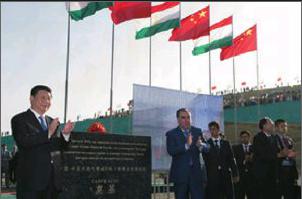A Serendipitous Project
2015-06-23ByLiZiguo
By+Li+Ziguo

Central Asian countries have shown a high-level interest in Chinas initiative of reviving the ancient Silk Road since the plan was proposed by Chinese President Xi Jinping during his visit to Kazakhstan in September 2013.
As an indispensable link between China and the western end of the Eurasian continent on the map of the Silk Road in history, the Central Asian region today is expected to share the benefits of the regions economic development by participating in the China-proposed Silk Road Economic Belt Initiative.
Beginning moves
In history, many ancient cities in the Central Asian region—such as Samarkand, Bukhara and Alma-Ata—thrived due to their respective locations along the old Silk Road route. In a sense, China and Central Asian countries share the same sentiment toward the Silk Road.
For this historical reason, governments of Central Asian countries welcome the Chinese initiative to revive the ancient route. Nursultan Nazarbayev, President of Kazakhstan, applauded the initiative when it was first raised by visiting Chinese President Xi in 2013. As a follow-up effort, Kazakhstan and China signed a memorandum of understanding on this initiative in December 2014.
Kyrgyz President Almazbek Atambayev said in September 2013 that his country would support the initiative and be willing to expand cooperation with China on trade, energy, connectivity, cultural and people-to-people exchanges.
In August 2014, Uzbek President Karimov said that his country would like to participate in building the proposed Silk Road Economic Belt and join the China-proposed Asian Infrastructure Investment Bank (AIIB), as well as accelerate the construction of a railway linking Uzbekistan, Kyrgyzstan and China.
In 2014, Tajikistan and Turkmenistan respectively signed a declaration with China, in which they expressed their interest in and commitment to the initiative.
Except Turkmenistan, other four Central Asian countries—Kazakhstan, Uzbekistan, Kyrgyzstan and Tajikistan—have joined the AIIB. In particular, the first two were among the first 21 countries that signed a memorandum of understanding on the establishment of the AIIB in Beijing last October.
Early participation has yielded great results. In May 2014, a logistics center sponsored by China and Kazakhstan was put into operation in the port of Lianyungang of east Chinas Jiangsu Province, through which products from Central Asia can be more effectively shipped to the rest of the world. China and Kazakhstan will, in the future, develop a logistics center serving all members in the Shanghai Cooperation Organization(SCO).
Common interests
Why do Central Asian countries lend such strong support to Chinas proposal to revive the ancient route? A key point is that it conforms to their respective strategic interests. The Central Asian regions geographic location makes it possible to link two large economic circles—Europe and the Asia Pacific—together.
Central Asian countries have all aspired to take advantage of their location to be an important transportation hub linking the east end of the continent to the west end.
In his State of the Union Address this year, Kazakhstans President Nazarbayev put forward the Bright Road, a national development blueprint that gives priority to building the country into a transit passage for international goods. In May 2014, Nazarbayev said that it is necessary to build a new railway route from Aktau, a Caspian Sea port of the country, to China.
The government of Tajikistan stressed in its national development strategy that the country must build a transportation network connecting all directions internally and externally.
In December 2014, Uzbek President Karimov, when summarizing the nations economic development, said that the countrys economic modernization wont be achieved if it fails to improve its infrastructure nationwide—especially those that involve public information and transporta-tion. Consequently, in March, Uzbekistan issued a transportation development plan for 2015-19.
In a plan that began in 2013 and will stretch to 2017, Kyrgyzstan has prioritized transportation, power and mining development.
A Turkmenistan-sponsored resolution on the role of transport and transit corridors in ensuring international cooperation for sustainable development was adopted at the 69th session of the UN General Assembly on December 19, 2014.
Clearly, Central Asian countries are in urgent need of building connectivity to boost development nationally.
The China-proposed Belt Initiative is in line with the industrial development demand for Central Asian countries. They share a lot in common with regards to their national situations: They are all developing countries with the same goal of developing industries to create job opportunities and improve peoples lives. Employment pressure in those countries is particularly heavy among younger generations.
In its development blueprint Kazakhstan-2050, the country plans to double the export of processed products by 2025. It has also issued a series of policies to support this round of industrialization.

In March, Uzbekistan released a fiveyear plan for boosting local production through attracting foreign investment. Three other Central Asian countries also announced their respective plans for promoting industrialization.
Diversifying energy exports is a longterm national strategy for Kazakhstan and Turkmenistan, which are abundant in energy resources. Efforts are on the way such as the construction of the natural gas Line-D from Central Asia to China and the extension of an oil pipeline from Kazakhstan to China. These projects will secure Kazakhstan and Turkmenistans positions in China—the largest future energy market in the world.
A core mission in the Belt Initiative involves developing transportation connectivity, improving conditions for more convenient logistics, accelerating industrial cooperation and establishing industrial zones according to the demands of countries along the belt—all of which conveniently match the goals of Central Asian countries. Moreover, China can meet these countriesdemands by establishing industrial projects and offering investment funds.
Risks ahead
Currently, many Chinese enterprises have picked up the pace in their efforts to go abroad, particularly to Central Asian countries. However, risk assessments must be carried out prior to the construction of any large project.
The security situation in the Central Asian region has been affected by extremism and terrorism, which will pose threats to major aspects of the Belt Initiative—for instance, transnational natural gas lines.
Infrastructure construction—like that of roads—always needs a lot of investment while the return period is a long. The question of how to ensure those projects to bring benefits to both investors and local people will remain a major focus throughout the process.
Enterprises must consider effects on local citizens whenever they invest abroad. But many Chinese enterprises lack such awareness and experience. Many of them tend to concentrate on negotiation with governments while ignoring the appeals of local residents. For example, local residents clashed with Chinese investors on a gold mine project in Kyrgyzstan, which had damaged the reputation of Chinese investors. The event serves as a warning for Chinese enterprises.
Differences in opinion are nothing new in matters between countries. For example, Kyrgyzstan hopes the transnational railway linking China, Kyrgyzstan and Uzbekistan can include a roundabout route into the countrys north region. If so, the project will face huge investment and construction risks.
Of course, risk can come with great rewards.
China and Central Asian countries should seek consistency to resolve divergences and difficulties through sincere cooperation. Currently, SCO members have maintained sound cooperation in the fight against terrorism and extremism and have secured the safety of major projects. They are extending the political mutual trust to economic cooperation.
When investing overseas, Chinese enterprises should bear in mind that creating job opportunities and protecting environmental for local people are part of their responsibilities. The purpose of sustainable investment overseas involves not only the pursuit of profit but also the overall betterment of the lives of local people.
